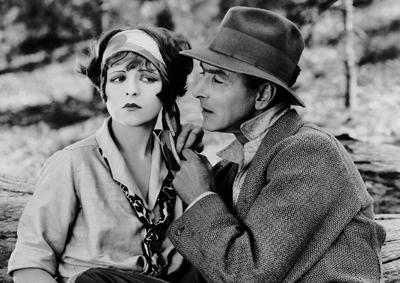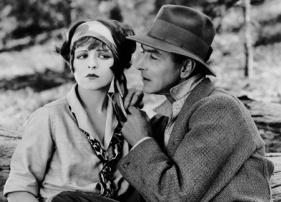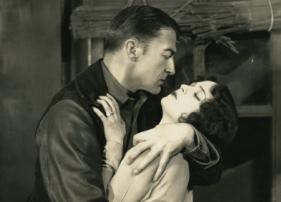"Miss Bow just walks away with the picture from the moment she steps into camera range" - Variety
Musical accompaniment will be provided by Cliff Retallick.
Mantrap / Midnight Madness

Musical accompaniment will be provided by Cliff Retallick.
Preservation funded by David Stenn
Mantrap (1926)

Directed by Victor Fleming
Ralph Prescott, a New York divorce lawyer and his buddy, E. Wesson Woodbury, decide to get away from it all on a camping trip near Mantrap, Canada. However, the city slickers are a bit out of their depth in the North woods. After the two get into a tussle, Joe Easter, the local trading post owner, takes Prescott to Mantrap, where Prescott meets Joe’s new flirtatious wife, Alverna (Clara Bow). The sparks begin to fly…
Paramount Pictures paid $ 50,000 for Sinclair Lewis’ long and justifiably forgotten novel, "Mantrap," but happily, the female screenwriters turned Lewis’ misogynistic tirade into a funny comedy romp that is light as a feather. The credit goes to Clara Bow who represents an erotic whirlwind in an otherwise womanless Western wilderness; an outrageous, good-time girl who leads at least two men by the nose, but nevertheless eventually honors her commitment--at least until the next interesting prospect comes along. Bow, of course, perfectly embodied the Jazz Age, the first era in American history to celebrate women’s sexuality as something other than a function of man’s desire. Although Bow had at that point made over thirty films in four years, Mantrap was her breakthrough. Variety noted almost ecstatically in its review of the film: “Clara Bow! And how! What a ‘mantrap’ she is! And how the picture is going to make her!... Miss Bow just walks away with the picture from the moment she steps into camera range.” Ernest Torrence, who could play monsters such as the brutal operator of an orphanage in Sparrows (1926), opposite Mary Pickford, here plays an easy-going and somewhat gullible giant. Neither Easter nor Prescott have a clue how to control the in-your-face vitality of Alverna, who makes no apologies for her manipulation of anyone with pants on. The film was shot at Lake Arrowhead by Victor Fleming, who was not necessarily known as a comedy director, but does elicit comedy performances with impeccable timing, a feat he would accomplish again with Jean Harlow in Red Dust (1932).
Jan-Christopher Horak
Famous Players-Lasky Corp./Paramount Pictures. Screenwriters: Adelaide Heilbron and Ethel Doherty. Based on the novel by: Sinclair Lewis. Cinematographer: James Howe. With: Ernest Torrence, Clara Bow, Percy Marmont, Eugene Pallette, Tom Kennedy
35mm, b/w, silent, approx. 75 min.
Preserved in cooperation with Paramount Pictures from a 35mm acetate fine grain master positive. Laboratory services by YCM Laboratories.
Preservation funded by Sony Pictures Entertainment
Midnight Madness (1928)

Directed by F. Harmon Weight
“Its very title reeks of strange people, mystery, suspense!” reads the advance publicity for this silent melodrama, loosely inspired by The Taming of the Shrew and directed by F. Harmon Weight. Secretary Norma Forbes (Jacqueline Logan) accepts the marriage proposal of Michael Bream (Clive Brook), wealthy diamond miner. Norma reveals to her boss and actual love interest (Walter McGrail) that she’s only marrying for the money. Having eavesdropped through a conveniently open door, Michael, despite his genuine affections, schemes to teach his gold-digging fiancée a lesson. From New York, the newlyweds sail second class to South Africa, where Michael leads his wife to believe that he is down-and-out. They settle in a bleak shack near a mine, where Norma discovers the hardships of life in the African jungle. She sends a cable to her former employer, divulging her whereabouts. A fight ensues, which leaves Michael bound up and prey to a lion. At last realizing her affection for her husband, Mrs. Bream returns with a shotgun – setting up a suspenseful climax that can only result in no lady or no lion.
In 1925, Cecil B. DeMille, by then one of Hollywood’s most bankable film directors, broke off with Paramount and the confines of the studio system to set up his independent DeMille Picture Corp. While the company’s biggest hit was the highly successful 1927 biblical epic The King of Kings, it mostly produced smaller melodramas, often involving the messy tangles of romance and capricious lovers. Ultimately, however, DeMille’s entrepreneurial efforts were met with a lack of success. In 1928 he returned to the studio system and signed with MGM, later rejoining Paramount, where many of his greatest successes were eventually produced.
Midnight Madness is mostly noteworthy as a remnant of this transitional period of DeMille’s career, and those of others. Little remains of the directing career of F. Harmon Weight who although noted in contemporaneous press reports as showing exceptional promise, did not survive Hollywood’s conversion to sound. The stardom of leading lady Jacqueline Logan (who achieved her biggest success as Mary Magdalene in The King of Kings) likewise waned with the onset of talking pictures. Meanwhile, Paramount star Clive Brook, often cast as the reserved Englishman, successfully bridged the sound gap and continued his prolific career in Hollywood and later in his native Britain.
Jennifer Rhee
DeMille Pictures Corp./ Pathé Exchange, Inc. Producer: Hector Turnbull. Screenwriter: Richard N. Lee. Based on the play "The Lion Trap, a Comedy in Four Acts” by Daniel Nathan Rubin. Cinematographer: David Abel. Editor: Harold McLernon. With: Jacqueline Logan, Clive Brook, Walter McGrail, James Bradbury, Oscar Smith.
35mm, b/w and tinted, approx. 65 min.
Preserved by Sony Pictures Entertainment and UCLA Film & Television Archive from a 35mm nitrate print. Laboratory services by Film Technology Company, Inc. Additional laboratory services by The Stanford Theatre Film Laboratory.
This film was preserved through a partnership of the New Zealand Film Archive, the American archival community, and the National Film Preservation Foundation, as part of a project supported by Save America’s Treasures, a partnership between the National Endowment for the Arts and the National Park Service, Department of the Interior.
Preservation funded by The Packard Humanities Institute
Movie Lovers Contest, No. 10 (1926)
35mm, tinted, silent, approx. 2 min.
Preserved from a 35mm nitrate print. Laboratory services by The Stanford Theatre Film Laboratory.
To report problems, broken links, or comment on the website, please contact support
Copyright © 2025 UCLA Film & Television Archive. All Rights Reserved